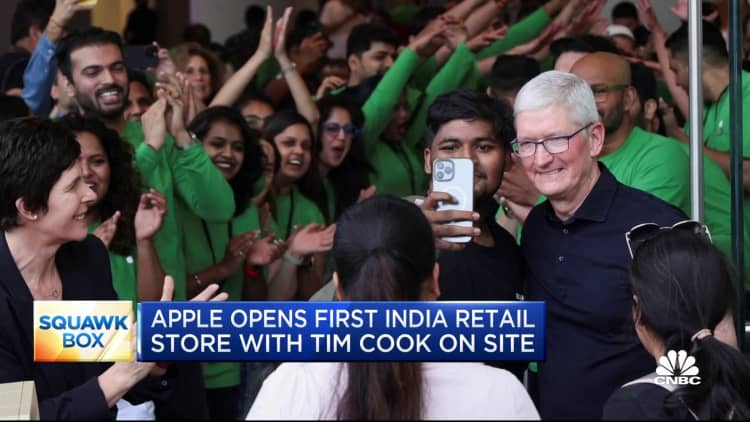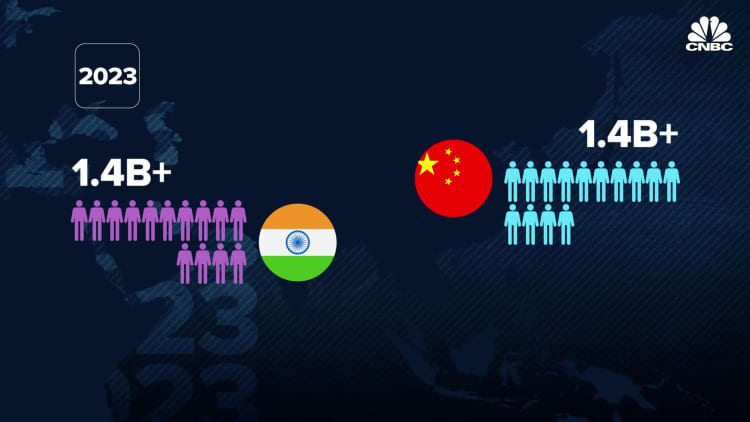Apple’s first physical retail store is located in the populous city of Mumbai.
Thank you for reading this post, don't forget to subscribe!Punit Paranjpe | Afp | Getty Images
For years, Tim Cook has been bullish on India. Now, he’s betting big on the South Asian giant as Apple shifts its focus away from China and expands its footprint in India.
Still, analysts told CNBC the iPhone-maker’s dependency on China will remain for years to come.
There’s potential for India to “become the next China” for Apple production, but it could take as long as a decade before it happens, said Martin Yang, senior analyst of emerging technologies at Oppenheimer & Co.
Apple is set to open its second India retail store in Delhi Thursday, two days after opening its first in Mumbai.
The Cupertino-based tech giant still has a strong presence in China due to its supply chain partners, and China’s infrastructure capabilities are still far better than what India can offer, Nitin Soni, senior director at Fitch Ratings told CNBC.
“It will take Apple years to diversify away from China,” Soni said. “The country is still a very large pocket for Apple — not just in the assembly line, but the semiconductor ecosystem and testing as well.”
Apple’s efforts to move its assembly of products from China became more urgent in the last five years as U.S.-China trade tensions intensified, and supply chain disruptions caused by Beijing’s zero-Covid policy unraveled. The iPhone maker had to scale back production in China due to those restrictions, a move that hurt its bottom line.
The population growth and pure opportunity around India is the golden goose for Apple.
Dan Ives
Wedbush Securities
It is also highly unlikely that Apple will be able to completely eradicate its reliance on China, said Navkendar Singh, an associate vice president with International Data Corporation (IDC) India.
“Given the cost scales, logistics, and sheer inertia of some of the suppliers in the ecosystem in China, it’s very unlikely that Apple can completely remove itself from China,” Singh highlighted.
Nevertheless, Apple’s growth in India has only just begun and numerous opportunities await in both manufacturing production and retail sales in the country.
Apple’s ambitions for India
India is the second largest smartphone market worldwide for annual shipments and sales, accounting for almost 12% of the global market, according to data from IDC.
According to the market intelligence firm, Apple shipped 6.7 million iPhones in 2022 from India, a surge from 4.8 million devices in 2022. It stands at the sixth position after the U.S., China, Japan, U.K., and Germany for global iPhone shipments in 2022.
“The population growth and pure opportunity around India is the golden goose for Apple. It’s been a difficult market to ramp for Apple on the iPhone front over the years but now is clearly starting to find its stride,” Dan Ives, analyst at Wedbush Securities, said.

The technology giant currently manufactures 5% to 7% of its iPhones in India, a leap from just 1% in 2021 — and there’s no stopping there with further plans in the works to increase the company’s prominence in the country.
“China and the US along with Europe remain the hearts and lungs of the Apple story with India set to become a top 5 market focus for Apple. High hopes India can be a major incremental growth driver for Cupertino in the years ahead,” Ives told CNBC via email.
Although the Indian government said in January that Apple is aiming to make 25% of all of its iPhones in India, Ives said that’s a “lofty” goal and hitting 10% to 15% of production seems more realistic in the long term.
India will also continue to play second fiddle to Vietnam in the production of more sophisticated products such as the MacBooks, but smaller products such as Apple’s smart watches and AirPods being manufactured in India soon, Singh said.
There is such a concentration of the market in the urban centers, and Delhi and Mumbai “make up almost a quarter of the market for Apple [in India],” IDC’s Singh said, adding that more physical stores could open by the middle of 2024.

India’s rising middle class
IDC data showed Apple only has a 5% market share in India since low-to-mid-tier priced devices continue to be consumers’ top choices.
However, the country’s increasing adoption in technology and stronger spending power from consumers will generate higher iPhone sales, Fitch’s Soni said.
“We see that the middle class is becoming more affluent and moving towards the upper middle class, and there is an increasing trend of customers buying flagship smartphones,” Soni said. “This is also helped by the fact that 4G is now easily available all over India.”

But cheaper labor costs in India will not reduce the costs of Apple’s iPhones as customers would be willing to pay premium prices for Apple products, Singh said.
Apple will not reach the “price point of the mass market,” he said. “It remains a premium brand and they would love to keep that brand halo in place.”
Singh added that the company may instead offer schemes or bank tie-ups to make products more affordable.
— CNBC’s Arjun Kharpal contributed to this report.

